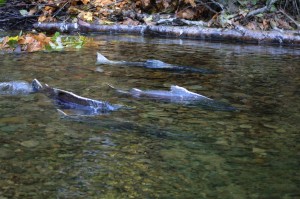By Gabe Scott
Alaska King Salmon are facing a crisis. The last several years have seen drastic declines in returning King Salmon runs, costing commercial fishermen millions, closing popular sport fisheries, and leaving subsistence fish camps in the villages empty.
Something is wrong, but what? That was the topic of a science symposium, put together by the Alaska Department of Fish & Game, that I and several hundred other Alaskans attended last week in Anchorage.
The State of Alaska has only grudgingly recognized that there is a King Salmon crisis. Locals have been screaming for years, but things finally came to a head this past year when runs were so bad the State had to close the popular Kenai River King fishery. Governor Parnell announced assembly of a ‘Dream Team’ of scientists to study the problem and suggest solutions. Given the anti-science, pro-oil predilections of our Governor, skepticism that the State will do anything is high.
State biologists, to their credit, have been relatively clear-eyed in their assessments and precautionary in their management actions. Every year fish are counted, escapement goals are set, and fishing is restricted when runs are too small.
This crisis highlights the importance of the ecological sciences. Complex webs of interrelation define ecology. Ecological knowledge is difficult to come by. It takes patience, persistence, and dogged determination, none of which are particular virtues of modern society. Alaska currently practices what amounts to an ignorance-based fishery management policy. The list of things we don’t know is astounding.
We don’t know how many fish spawn in rivers, nor how many head out to sea. On the Copper River, for example, the only method of counting fish is a fish-counting sonar station that doesn’t distinguish between Sockeye and Chinook salmon. There is a mark-recapture program, but funding for that rudimentary tactic faces cuts. The only thing we know for sure is that the King catch is way down.
We don’t know where the fish go. We know it must be somewhere, and that preliminary studies show stock-specific migrations. For example Chilkoot River Kings seem not to stray beyond the nearby Lynn Canal, while Columbia River Kings make an incredible northward migration to Southeast Alaska waters. Managing a migratory species is awfully hard when you don’t know where they are migrating.
We know almost nothing about marine carrying capacity. We don’t know what predators King Salmon fear, or what their competitors are for food. This is important to the question whether flooding the ocean with hatchery-raised salmon might be impacting on wild stocks in non-obvious ways.
There is a whole lot we don’t know about climatic patterns in the ocean. It is fairly clear that the Bering Sea tends to cycle through relatively warm and cool periods, but how frequent are these cycles? What drives them? And significantly, what impact is global climate change having on them? Nobody knows, but things don’t look good. One model showed that by 2080, the Gulf of Alaska would not provide viable habitat for Sockeye Salmon.
Traditional fishery management tools are failing us. State managers do a good job with the information they have, but the information they have isn’t close to enough. If the Kings are dying somewhere out in the ocean, then it does no good to allow more of them to spawn in the river. The problem is that, because of our ecological ignorance, current management places the burden of conservation on the person standing at the end of the line — the upriver fisherman — even thought it is pretty clear that person isn’t the problem.
So what should be done about the King Salmon crisis? Three immediate steps are no-brainers.
First, some form of emergency relief needs to be crafted for subsistence users. It is not fair to demand an Alaska Native who has been fishing a river for thousands of years, to go hungry, while asking nothing of the industrial trawlers, hatcheries, and polluters who more likely are causing the problem. The gulf of respect between government fishery managers, and traditional fishermen, needs to be bridged.
Second, the government needs to get serious about funding basic ecological research. Playing dumb doesn’t cut it, not with so much at stake. I grew up watching Jacques Cousteau specials, and their simple underlying message remains more important than ever today. Studying the ocean isn’t just academic; it’s the key to respecting and conserving the life of the planet.
Third, conservation, conservation, conservation. The precautionary principle holds that uncertainty isn’t a reason not to take preventive action. Uncertainty about exactly how global climate change will muck up the gears, isn’t a reason not to immediately get serious about conservation. We need to get off of fossil fuels yesterday, and be proactive about enforcing the Clean Water Act.
The things happening in the Pacific Ocean are important to our home here in Cascadia. Our vision of the future has towering old-growth forests, wolves howling in the backcountry, and rivers full of salmon. We’ve made immense strides on the forest, and wolves are again howling at the moon. But, if we don’t pay attention to the ocean, the rivers may be empty even if the waters are pure and forests intact.
Understanding how nature works is difficult, but managing our fisheries based on ignorance is more difficult still.


Surprised there was no mention of trawling by catch in your article. Those with long memories and more years in our state remember that the effect on salmon runs was one of the reasons the state and US worked together to kicked the Japanese trawlers out. Alas — a change in politics, and along came Oregon trawlers to our state. We allowed fellow Americans to do this to us.